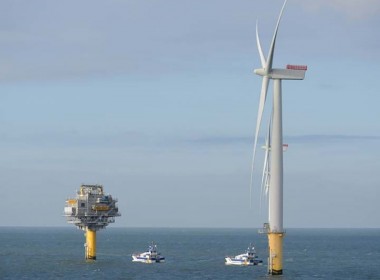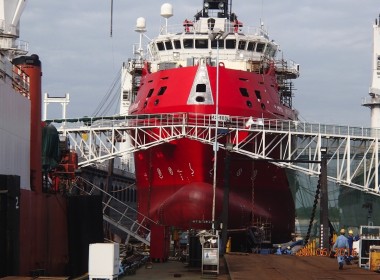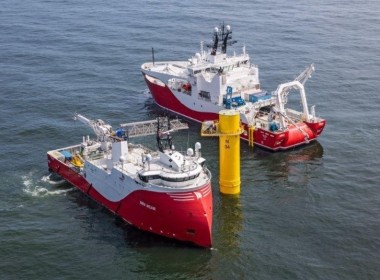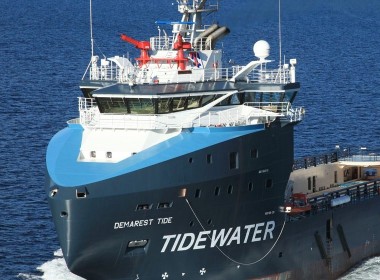COLUMN | Rich flags, poor reports… – Part 1 [Offshore Accounts]

On the First Day of Christmas, my true love (the Ministry of Transport in Singapore) didn’t give to me….one missing accident report into the sinking of the liftboat Teras Lyza.
Look on the website for Singaporean Marine Safety Investigation Reports here and you find nothing….not a single publicly available report into any accident since March 15, 2018, when APL Southampton collided with a fishing vessel, and absolutely nothing on the curious loss of the Singapore-flagged jack-up en route to Taiwan, more than 18 months ago.
In a city state famed for its efficiency, this seems remiss, especially since it was half owned by a large Singaporean listed company, Ezion. By contrast, the UK’s Marine Investigation Branch is already publishing its findings for incidents which took place in 2019 here.
So, we must wait and wonder why Teras Lyza turned over on June 5, 2018 whilst under tow by an Ezion-owned tug. Fortunately, the liftboat was unmanned the accident occurred. The stricken jack-up was later towed away, scuttled and sunk in deep water off the Philippines by Resolve, its salvors, in August 2018.
Why does this matter? Nobody died or was injured, and Resolve did an excellent job of minimising any environmental impact, pumping out the diesel bunkers onboard before they sank the barge.
However, it should be self-evident that the lessons from this incident need to be disseminated as widely as possible, given that this lift boat could accommodate 85 crew and passengers. Had the unit capsized in different circumstances, when fully operational off Taiwan, for instance, there could have been massive loss of life. Consider this a “near miss” which the Singapore flag state should be treating very seriously and investigating stringently.
Firstly, the role of the warranty surveyor who signed off on the tow, and the operations team in Teras responsible for it, need scrutiny. June is in the middle of the typhoon season in the South China Sea, and Tropical Storm Ewiniar was active in the area at the time the liftboat sank, making landfall over South China the day after the incident.
Too often warranty surveyors are treated as inconvenient costs, delaying tows and interfering with operational planning, especially when the unit is being towed “in-house” by the owner’s own vessels.
We have previously covered the catastrophic loss of Maersk Supply Services anchor handlers on the way to being scrapped in 2016, which was the subject of a comprehensive investigation by the Danish authorities, published here, showing the owner’s disregard for best practice, its poor planning, and total operational disorganisation in its in-house towing.
It would be useful to know how the warranty survey process was conducted for the tow of the Teras Lyza, the route planning, and what were the weather conditions in which the roll-over occurred.
So far, Ezion has been tight lipped on the conditions, but the investigators might need to look at the decision making process which led to the routing of the tow through the typhoon belt when there was an active tropical storm in the vicinity, and what restrictions the warranty surveyor had placed on the tow.
Have the Singaporean authorities taken detailed testimony from the tug captain on the performance of the tow and the events leading up to the disaster? Without a public report, who knows?
Then there needs to be considerable effort placed in investigating the design and stability of the Teras Lyza. It goes without saying that it is very unusual for jack-ups to randomly roll over, thankfully. Punch-throughs are much more common.
We would hope that the Singapore authorities will look at whether design issues and any modifications to the original design contributed to the sinking. The unit was classed by ABS, built in the now-bankrupt Triyards facility in Vietnam, and was designed by the little-known design house AK Suda in the US. Full specifications are here.
There are allegations that changes ended up leaving the jack up with a much higher light displacement than originally designed, and a very low freeboard. This would have potentially contributed to stability problems, which may have been a factor in the loss. We understand that due to the low freeboard, side spud cans were fitted to Teras Lyza, and to accommodate them, the Vietnamese yard had to shift much of the deck equipment to higher levels, potentially further decreasing the stability of the vessel. Is this so?
Just as warranty surveyors are there to protect the safety of tows and the crews of the tugs towing them, so class is there to protect seafarers and the environment as well. One would hope that the Singapore Ministry of Transport will be looking closely at the design compliance process, any “as built” modifications to the Teras Lyza, and their impact on the unit’s stability.
With Triyards’ financial distress this may prove difficult, but ABS should have every incentive to co-operate with Singapore’s investigation. and Teras’ technical team should also provide testimony.
In short, the sinking of Teras Lyza raises many questions, questions which Singapore’s Ministry of Transport need to address in an open, thorough and diligent report, which should be publicly available and issued in a timely manner. The sinking of this jack up fortunately occurred without loss of life, and it provides an opportunity for the entire offshore industry to learn from the experience.
Though it misses the point of the article entirely, AK Suda’s Ajay Suda has responded here.
Background references
Those interested in lift-boat safety can read a comprehensive report into the unfortunate safety record of the Gulf of Mexico fleet in the 1980s here:


![COLUMN | Rich flags, poor reports… – Part 1 [Offshore Accounts]](https://www.bairdmaritime.com/wp-content/uploads/OFFSHORE-WEEK-Banner-860x130.gif)






